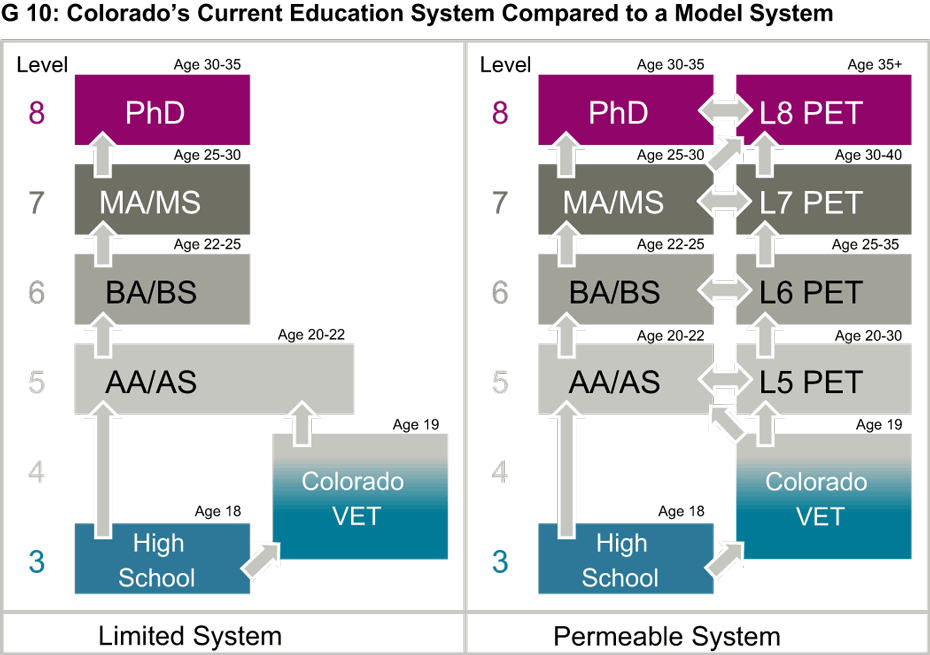System of Opportunity: Permeable Education and Training in Colorado
- KOF Bulletin
- Vocational Education and Training
Youth apprenticeship is a major topic globally. In the United States, Colorado’s current pilot youth apprenticeships — implemented by CareerWise Colorado in partnership with companies, schools, state leaders and philanthropic partners — are the most compelling. The two pilot cohorts already under way are anecdotally very successful, with students and companies reaping rewards from participation.
A report by Katherine Caves and Ursula Renold, both from KOF, in collaboration with Uschi Backes-Gellner from the University of Zurich, explores future options for transitioning the pilot programme into a fully integrated programme that is part of a permeable education and training system.

An integrated programme
At the moment, Colorado’s pilot apprenticeships have a separate curriculum from the high-school education component. However, this approach is one of the first that allows students to pursue both school and workplace learning simultaneously. This is a decisive step towards a programme that unifies education and training.
An integrated vocational education and training (VET) programme includes both general education and occupation-specific training under one curriculum and leads to a single qualification that recognises both education and training. The curriculum covers all competencies learned at work and in school, including general education requirements and the needs of the training occupation. Figure G 9 shows the difference between apprenticeship alongside education and an integrated VET programme with the same timeline.
The two models are not equivalent. Separating the education and training parts into separate qualifications and programmes — even aligned programmes — devalues both. Unifying both education and training under a single curriculum makes teaching and training more efficient and effective, and allows the final qualification to more accurately reflect participants’ knowledge and skills. Furthermore, it facilitates students’ transition into work, continued professional education and training, or further education.

A permeable education system
Colorado’s future VET programme should be embedded in a permeable education system comprising programmes of many levels and types. In addition to the individual programmes, the system includes transition mechanisms, intermediary and facilitation capacities as well as guidance and support services for students. It should be governed by a legislative framework that describes roles, responsibilities and resources. This system is the ecosystem that makes each programme valuable individually and enables individuals to follow productive and satisfying lifelong learning pathways.
Figure G 10 shows Colorado’s current formal education system and a model future system. The most common way of describing education levels is to use the International Standard Classification of Education1 (ISCED), with levels zero to nine. These are on the left of each image. The academic side already covers all levels and, for a fully permeable system, Colorado needs VET as well as numerous professional education and training (PET) programmes at levels five to eight. Without these, improvements in VET are just another path into university.

In the limited system there are no formal, non-academic qualifications. In contrast, the revised system is permeable. Permeability is two-dimensional, covering both access and opportunity.
Access means individuals can enter programmes based on clear entry conditions and from various starting points. For example, American students can enter four-year universities directly from high school, as transfer students from community colleges or later in life after working for some time. All students are eligible to earn undifferentiated bachelor’s degrees regardless of their starting points. Opportunity means that there are multiple formal programmes throughout the education system, covering diverse levels and types of skills and knowledge – for example, both VET and academic high school at the upper-secondary level.
Access is already a priority in Colorado, so bringing it up to the necessary level is more of a tweak than a radical change. As a starting point, tertiary education programmes need to account for related VET in their entry criteria. Opportunity is less developed in Colorado for a number of reasons. The most critical reasons are that the current youth apprenticeship pilot does not have any stand-alone formal certification, and there are extremely limited PET options — none of which is part of a formal education system with clear levels.
Contact
No database information available
No database information available